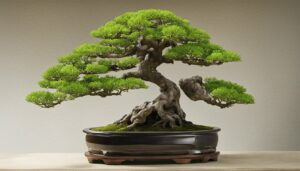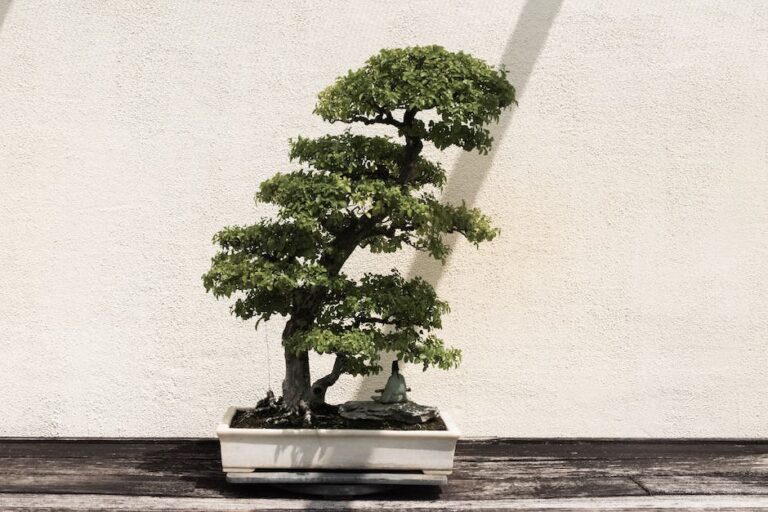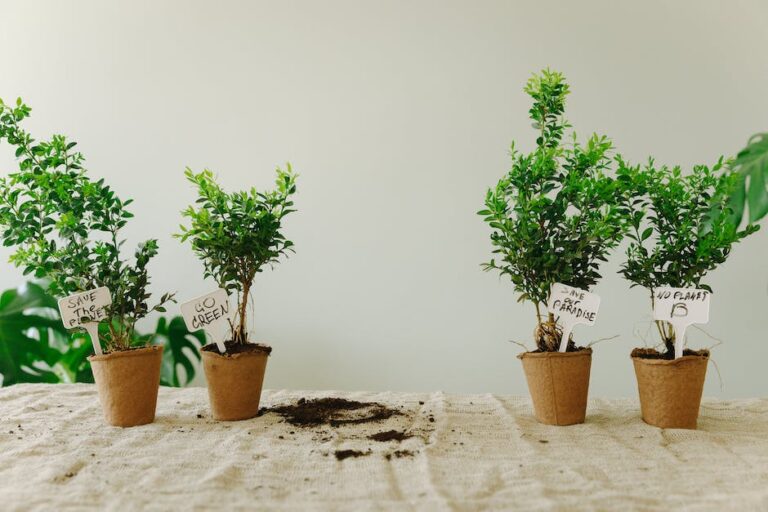Bonsai Tree Or Topiary
Whether you’re looking to cultivate a miniature masterpiece or shape nature into whimsical  forms, bonsai trees and topiaries offer an artistic touch to your surroundings.
forms, bonsai trees and topiaries offer an artistic touch to your surroundings.
In this article, we explore the history, types, and care techniques of bonsai trees, along with the captivating world of topiaries.
Discover the benefits of nurturing a bonsai tree and the artistry involved in crafting and maintaining topiary artworks.
Let your creativity flourish as you delve into the enchanting world of bonsai trees and topiaries.
Key Takeaways
- Bonsai trees originated in China and spread to Japan, where they hold deep cultural significance and symbolize harmony, balance, and patience.
- There is a wide range of bonsai tree varieties, each with its own unique characteristics and care requirements, such as Japanese maple and elegant juniper.
- Pruning and shaping techniques are essential for maintaining the size and promoting new growth of bonsai trees, including trimming branches and roots and using wiring and bending to create unique forms.
- Proper care for bonsai trees involves regular watering, providing proper sunlight, using sharp and clean tools for pruning, and avoiding overwatering or allowing the soil to dry out completely.
History of Bonsai Trees
When learning about bonsai trees, you’ll find that their history dates back centuries. The evolution of bonsai techniques can be traced back to ancient China, where miniature trees were cultivated for aesthetic purposes. From there, the practice spread to Japan, where it became deeply ingrained in their culture.
Bonsai trees are highly regarded in Japanese society and are often seen as a symbol of harmony, balance, and patience. The cultural significance of bonsai trees lies in their ability to capture the beauty of nature in a small, controlled space. They are a form of art that requires meticulous care and attention to detail.
Now, let’s explore the different types of bonsai trees and the unique characteristics they possess.
Different Types of Bonsai Trees
When it comes to bonsai tree varieties, there is a wide range to choose from. From the classic Japanese maple to the elegant juniper, each variety offers its own unique characteristics and challenges.
In order to care for your bonsai properly, it is important to understand the specific needs of the variety you have chosen, including factors such as light, water, and pruning requirements.
Bonsai Tree Varieties
There’s a wide variety of bonsai trees you can choose from. These miniature trees have been carefully cultivated and shaped over time to create stunning works of art.
When it comes to bonsai tree pruning, it is essential to maintain the tree’s shape and size. Pruning involves carefully trimming the branches and roots to promote healthy growth and maintain the desired shape of the tree.
Bonsai tree shaping, on the other hand, involves techniques such as wiring and bending to create intricate and unique forms. By shaping the branches and trunk, you can create a bonsai tree that reflects your personal taste and style.
Whether you prefer a traditional upright style or a more modern cascading design, there is a bonsai tree variety out there that will captivate and inspire you.
- Pruning: Regular maintenance to control growth and maintain shape
- Shaping: Techniques to create unique forms through wiring and bending
- Personalization: Reflect your taste and style through your bonsai tree
Care Tips for Bonsai
To keep your miniature tree healthy, water it regularly and make sure it receives the right amount of sunlight. Bonsai trees require specific care to thrive and maintain their unique shape and beauty. Proper pruning techniques and a consistent watering schedule are essential for their well-being.
When it comes to pruning your bonsai tree, it is crucial to understand its growth pattern and desired shape. Regular pruning helps maintain the tree’s size and encourages new growth. Use sharp and clean tools to make precise cuts, removing any dead or overgrown branches. This technique helps promote airflow and prevents disease.
In addition to pruning, establishing a watering schedule is vital for your bonsai’s health. The frequency and amount of water required depend on the tree species, pot size, and environmental conditions. It is essential to water thoroughly, ensuring the entire root ball is moistened. Avoid overwatering, as it can lead to root rot, but also prevent the soil from drying out completely.
Remember, proper care and attention are key to keeping your bonsai tree thriving. By following these pruning techniques and maintaining a suitable watering schedule, you can enjoy the beauty of your miniature tree for years to come.
| Pruning Techniques | Watering Schedule |
|---|---|
| Regular pruning helps maintain size and promote new growth | Water thoroughly, ensuring the entire root ball is moistened |
| Use sharp and clean tools to make precise cuts | Avoid overwatering and prevent soil from drying out completely |
| Remove dead or overgrown branches to promote airflow | Frequency and amount of water depend on tree species, pot size, and environmental conditions |
Techniques for Bonsai Tree Care
When it comes to caring for your bonsai tree, there are several key techniques you should keep in mind.
Pruning is essential for promoting optimal growth and maintaining the desired shape of your tree. By regularly trimming back overgrown branches and foliage, you can encourage new growth and keep your bonsai tree looking its best.
Additionally, proper watering and soil maintenance are crucial for the overall health and vitality of your tree. It’s important to provide the right amount of water, ensuring that the soil is moist but not waterlogged, and to regularly check the condition of the soil to ensure it remains well-draining and nutrient-rich.
Pruning for Optimal Growth
Trimming your bonsai tree or topiary regularly will promote optimal growth. Pruning techniques and shaping methods are crucial for maintaining the desired form and size of your bonsai or topiary. Here are some important points to consider:
- Pruning techniques:
- Regularly remove dead or damaged branches to stimulate new growth.
- Thin out dense areas to improve air circulation and prevent diseases.
- Use directional pruning to shape the tree and guide its growth.
- Shaping methods:
- Wiring allows you to bend and shape branches, creating the desired form.
- Pinching involves removing the tips of new growth to encourage branching.
- Leaf pruning helps maintain the tree’s overall balance and proportions.
By implementing these pruning techniques and shaping methods, you can create stunning bonsai trees or topiaries that are aesthetically pleasing and healthy.
Now, let’s move on to the essential aspects of watering and soil maintenance.
Watering and Soil Maintenance
Regularly watering your bonsai or topiary is essential for maintaining their health and vitality. Proper watering techniques depend on the type of tree and the soil composition.
Bonsai trees require careful attention to soil moisture levels. The soil should be slightly damp but not overly saturated, as excessive moisture can lead to root rot. One effective method is the ‘soak and dry’ technique, where you thoroughly water the tree until the water drains out of the bottom, and then allow the soil to dry out before watering again. It is also important to use well-draining soil that allows for proper air circulation and prevents waterlogging.
By understanding the specific watering needs of your bonsai or topiary, you can ensure that they receive the right amount of water to thrive.
Now let’s explore the benefits of having a bonsai tree.
Benefits of Having a Bonsai Tree
One of the benefits of having a bonsai tree is that it can help reduce stress levels. The art of cultivating and caring for a bonsai tree can be a form of meditation, allowing you to focus your mind and find tranquility in the present moment.
Here are some emotional responses that having a bonsai tree can evoke:
- A sense of calm and relaxation: As you prune and shape the bonsai tree, you can enter a state of flow, where your worries and anxieties fade away, and you become fully immersed in the task at hand.
- A feeling of connection with nature: Bonsai trees are miniature replicas of full-sized trees, and by nurturing them, you can experience the beauty and wonder of nature up close, even in the confines of your home.
- A sense of accomplishment and pride: Watching your bonsai tree grow and thrive can give you a sense of satisfaction and achievement, boosting your self-esteem and overall well-being.
Introduction to Topiaries
When it comes to creating and maintaining topiaries, you’ll find that the artistry lies in carefully sculpting shrubs and plants into unique and intricate shapes. Topiaries have been used for centuries to add beauty and elegance to gardens and landscapes. These living sculptures require special attention and care to ensure they maintain their shape and health.
One of the key elements of topiary design is the selection of plants. Not all plants are suitable for topiaries, as they need to be able to withstand frequent pruning and shaping. Some popular plants for topiaries include boxwood, yew, holly, and rosemary. These plants have dense foliage and can be easily manipulated into various shapes.
To give you an idea of the possibilities with topiary designs, here is a table showcasing some common shapes and the plants that work well for each:
| Shape | Plant |
|---|---|
| Sphere | Boxwood |
| Cone | Yew |
| Spiral | Holly |
| Animal | Rosemary |
| Geometric | Privet |
Creating and maintaining topiary artworks requires not only skill but also patience and dedication. In the next section, we will explore the techniques and tips for successfully shaping and caring for these living sculptures.
Creating and Maintaining Topiary Artworks
Maintaining the shape and health of topiary sculptures requires careful pruning and shaping techniques. To ensure the longevity and beauty of your topiary artwork, consider the following:
- Precision: Use sharp, clean tools to make precise cuts, ensuring the overall shape remains intact.
- Patience: Shaping a topiary sculpture takes time and patience. Slowly trim and shape the foliage, allowing the plant to grow and fill in the desired form.
- Artistry: Topiaries are a form of living art, so approach the shaping process with creativity and an eye for aesthetics. Experiment with different styles and designs to create unique and captivating sculptures.
Conclusion
In conclusion, whether you choose a bonsai tree or a topiary, you are embarking on a journey of artistry and patience. Both require careful attention and skillful techniques to maintain their intricate forms.
The history of bonsai trees and the art of topiary have evolved over centuries, showcasing the dedication and passion of gardeners and artists alike.
By nurturing a bonsai tree or crafting a topiary, you not only create a stunning display of nature’s beauty, but also cultivate a sense of harmony and balance in your surroundings.
So, embrace the art of miniature landscapes or sculpted hedges, and let nature’s coincidences amaze and inspire you.




